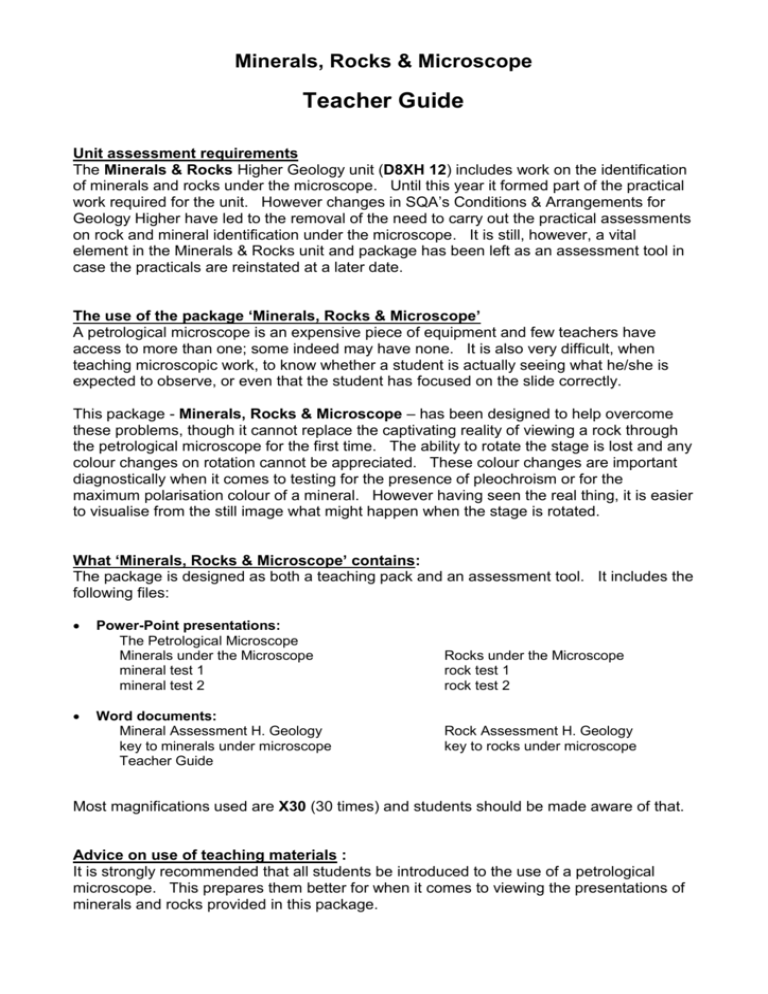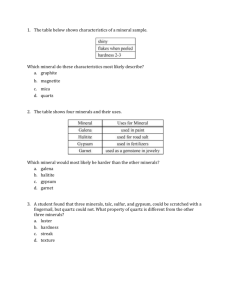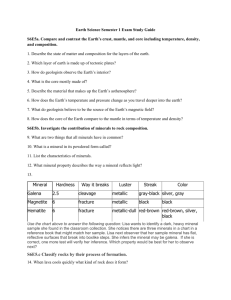Geology: Minerals, Rocks and Microscope Teacher Guide
advertisement

Minerals, Rocks & Microscope Teacher Guide Unit assessment requirements The Minerals & Rocks Higher Geology unit (D8XH 12) includes work on the identification of minerals and rocks under the microscope. Until this year it formed part of the practical work required for the unit. However changes in SQA’s Conditions & Arrangements for Geology Higher have led to the removal of the need to carry out the practical assessments on rock and mineral identification under the microscope. It is still, however, a vital element in the Minerals & Rocks unit and package has been left as an assessment tool in case the practicals are reinstated at a later date. The use of the package ‘Minerals, Rocks & Microscope’ A petrological microscope is an expensive piece of equipment and few teachers have access to more than one; some indeed may have none. It is also very difficult, when teaching microscopic work, to know whether a student is actually seeing what he/she is expected to observe, or even that the student has focused on the slide correctly. This package - Minerals, Rocks & Microscope – has been designed to help overcome these problems, though it cannot replace the captivating reality of viewing a rock through the petrological microscope for the first time. The ability to rotate the stage is lost and any colour changes on rotation cannot be appreciated. These colour changes are important diagnostically when it comes to testing for the presence of pleochroism or for the maximum polarisation colour of a mineral. However having seen the real thing, it is easier to visualise from the still image what might happen when the stage is rotated. What ‘Minerals, Rocks & Microscope’ contains: The package is designed as both a teaching pack and an assessment tool. It includes the following files: Power-Point presentations: The Petrological Microscope Minerals under the Microscope mineral test 1 mineral test 2 Word documents: Mineral Assessment H. Geology key to minerals under microscope Teacher Guide Rocks under the Microscope rock test 1 rock test 2 Rock Assessment H. Geology key to rocks under microscope Most magnifications used are X30 (30 times) and students should be made aware of that. Advice on use of teaching materials : It is strongly recommended that all students be introduced to the use of a petrological microscope. This prepares them better for when it comes to viewing the presentations of minerals and rocks provided in this package. Students should start with the study of minerals using the document ‘Minerals under the Microscope’. Work on the program can be done individually or as a whole class exercise, via the use of a projector; either way the teacher/lecturer would need to go over various points relating to the use of the program and to the identification of mineralogical features. It may be best to do this as a class exercise first and then let the students work through it on their own. Once the students have grasped the basics, the test can be given. The teacher can choose either mineral test 1 or 2 and conduct it as a whole class or let the students work at it individually if sufficient PCs are available. Each student needs to be issued with a copy of the ‘Mineral Assessment Higher Geology’ which they complete as the program runs and the ‘key to minerals under microscope’ which they need for reference. A pass requires the correct identification of 7 out of 10 minerals. A reasonable quality of description relating to each mineral is essential, although there will be items that do not apply in some cases – e.g. extinction angle does not apply to quartz or pleochroism to muscovite. Teachers are free to adjust the assessment sheets to include candidate number and name and number of centre. There is no time limit on the completion of the exercise, but a double period would be more than sufficient if done as a class exercise. Students should then move on to the study of rocks using the document ‘Rocks under the Microscope’. The procedure should be the same as for the minerals. A pass in the rocks element requires the correct identification of 8 out of 11. Again descriptions should be thorough. It is important that all students are made aware of how to work through the programs before any testing is done. George Strachan October 2005







